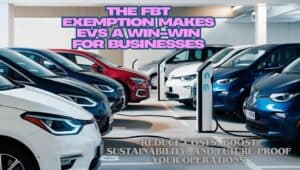Leverage Tax Savings While Driving Sustainability
Australia’s push toward net-zero emissions has made electric vehicles (EVs) a cornerstone of corporate sustainability strategies. For businesses, the federal government’s FBT exemption for eligible EVs offers significant financial incentives to transition to greener fleets. However, not all EVs qualify, and rules differ for plug-in hybrids (PHEVs).
In this blog, we break down the key details using guidance from the ATO’s latest resources (Electric Cars Exemption and FBT on Plug-In Hybrids).
What is the FBT Exemption for EVs?
The FBT exemption allows employers to provide eligible EVs to employees tax-free, saving businesses thousands in fringe benefits tax. Here’s how it works:
Eligibility Criteria
To qualify for $0 FBT, the vehicle must meet all of the following:
Emission Threshold: Emits <50g CO₂/km (applies to battery EVs and hydrogen fuel cell vehicles).
First Use Date: First held and used on or after 1 July 2022.
Purchase Price: Must not exceed the Luxury Car Tax (LCT) threshold for fuel-efficient vehicles ($89,332 in 2023–24).
Exclusions:
Most plug-in hybrids (PHEVs) do not qualify unless they meet the strict <50g/km threshold (rare).
Vehicles modified after purchase (e.g., luxury accessories) may exceed the LCT cap, voiding the exemption.
EVs vs. Plug-In Hybrids: Key Differences
| Factor | Battery/Hydrogen EVs | Plug-In Hybrids (PHEVs) |
|---|---|---|
| FBT Exemption | ✅ Exempt if criteria met | ❌ Only if <50g/km (unlikely) |
| LCT Threshold | $89,332 | $76,950 (general vehicles) |
| Running Costs | Lower (no fuel) | Higher (fuel + electricity) |
Why Most PHEVs Don’t Qualify:
PHEVs combine petrol engines with electric motors, typically emitting >50g CO₂/km when tested. Unless a PHEV meets the sub-50g threshold (e.g., short electric-only range), it will not qualify for the FBT exemption.
How Businesses Benefit
Savings on FBT
Employers avoid the standard 47% FBT rate on the vehicle’s taxable value.
Example: Providing a 70,000EVsaves 70,000EVsaves 14,000 in annual FBT compared to a petrol car.
Employee Salary Packaging
Employees can lease EVs via novated leases using pre-tax income, reducing their taxable income.
Combines with the FBT exemption for maximum savings.
Sustainability Credentials
Align with ESG goals and attract eco-conscious talent and clients.
Compliance Checklist
To claim the exemption, businesses must:
Verify Eligibility:
Confirm the vehicle’s emissions using the Green Vehicle Guide.
Ensure the purchase price (incl. GST/dealer fees) is under $89,332.
Track Usage:
Maintain a logbook to prove business vs. private use (if required).
Document Everything:
Keep purchase/lease agreements, registration papers, and emissions data.
Report in FBT Returns:
Declare the exemption in your FBT return (even though $0 tax is payable).
Pitfalls to Avoid
Overlooking Post-Purchase Costs: Adding accessories (e.g., roof racks, premium sound systems) could push the vehicle’s value over the LCT threshold.
Assuming All EVs Qualify: Some high-end EVs (e.g., Tesla Model X) may exceed $89,332. Always check the total cost.
Ignoring State Incentives: Pair the federal FBT exemption with state rebates (e.g., SA’s $3,000 subsidy, NSW’s stamp duty waiver).
The Future of FBT and EVs
Exemption Expiry: The policy currently applies to EVs first used by 31 March 2025, but extensions are possible.
Road User Charges (RUC): Some states plan to introduce RUCs for EVs (e.g., Victoria’s 2.8¢/km fee), but these are separate from FBT.
Ready to Electrify Your Fleet?
The FBT exemption makes EVs a win-win for businesses: reduce costs, boost sustainability, and future-proof your operations.
Contact us for tailored advice!
Drive green, save smart, and stay ahead of the curve! 🚗⚡






